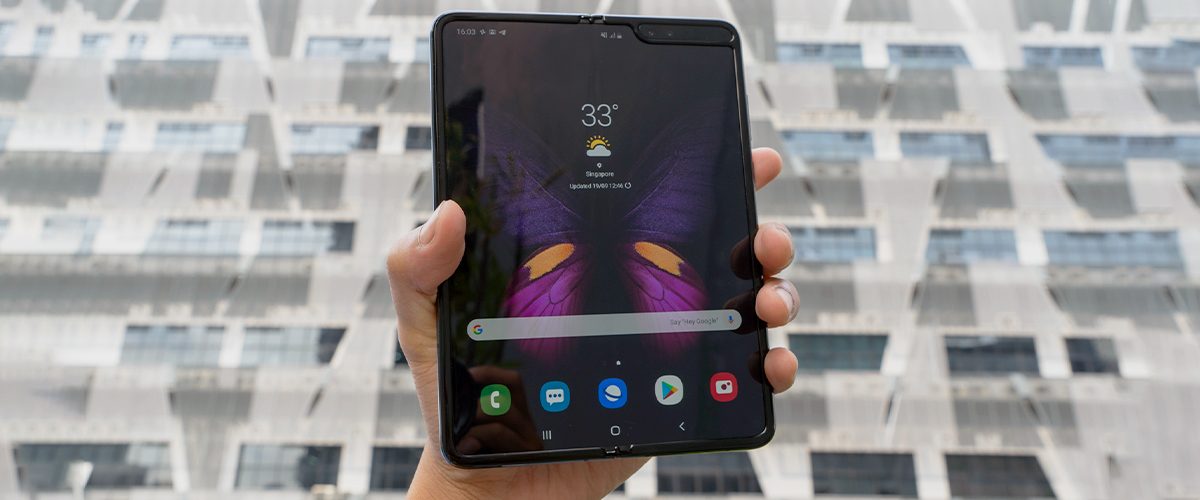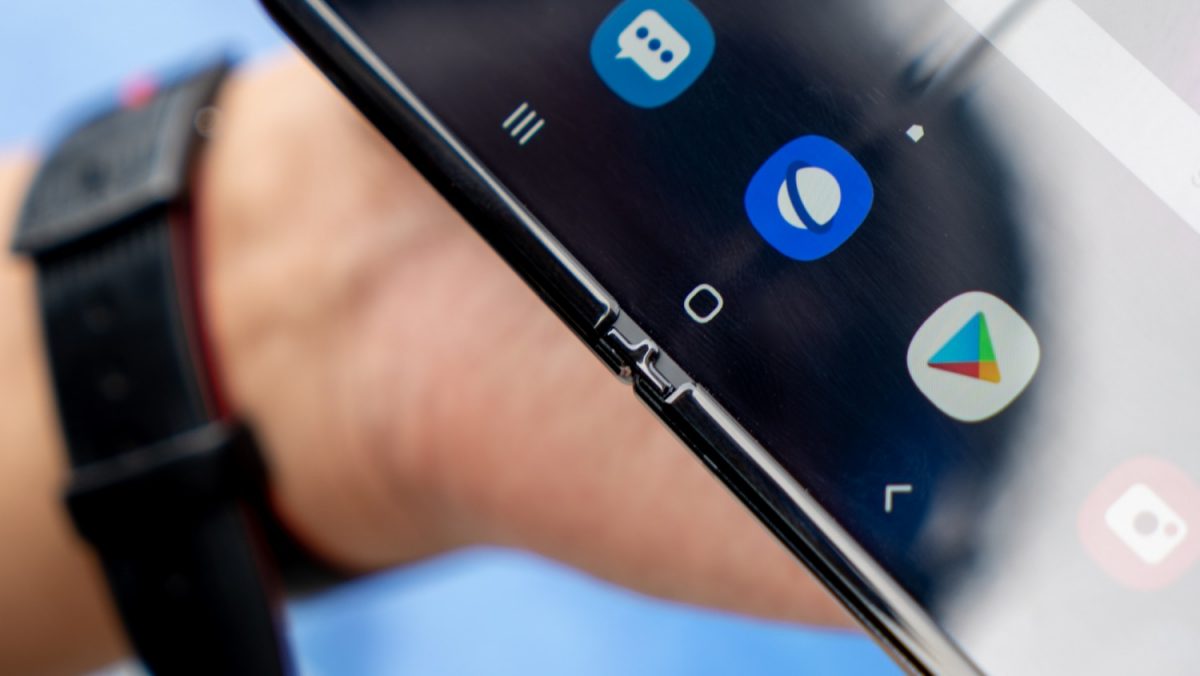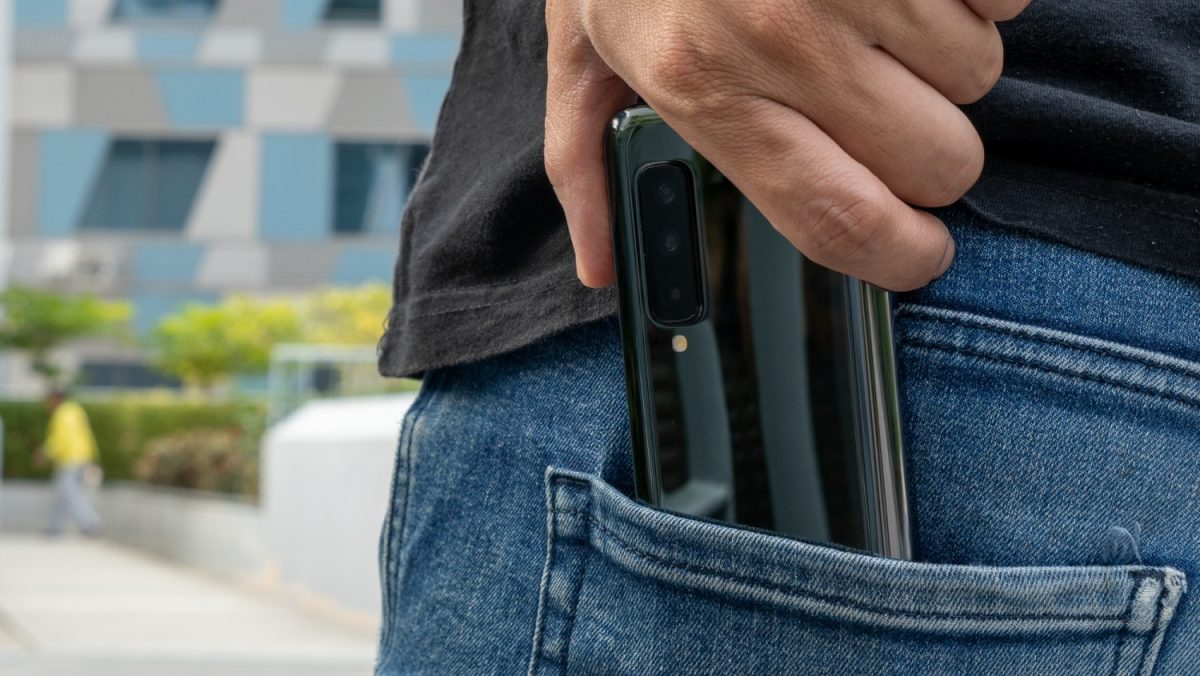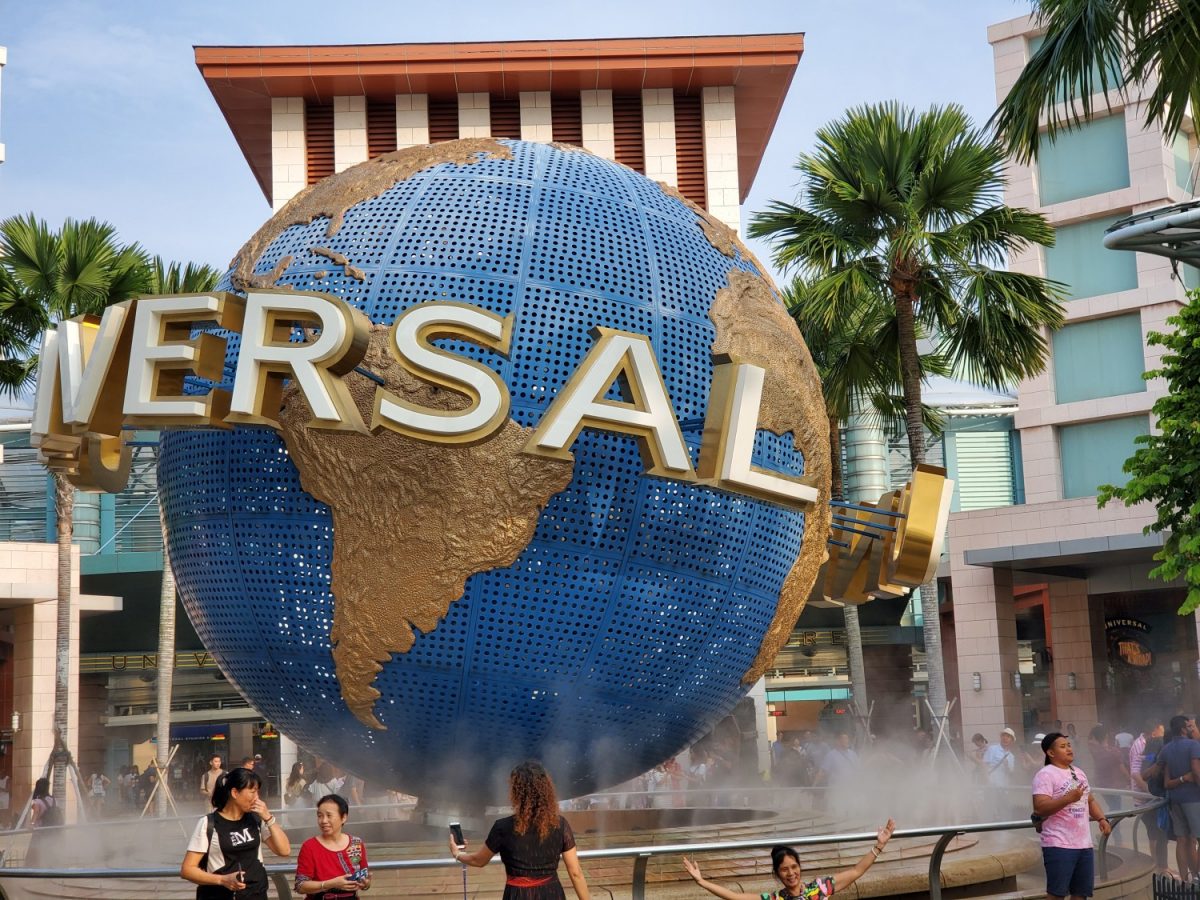Remember when flip phones used to be all the rage? There was the original Motorola StarTAC that was obviously based on the original Star Trek 6 Communicator, which has folks whipping the device from their back pocket, flipping them open with panache, and snapping them close with equal gusto.
But in the last two decades, all that pizzazz about flip phones were all but forgotten. However, as the rise of the touch-enabled Samsung Galaxy Fold and its ilk, that familiar feeling may yet make a return.

The Galaxy Fold opens up vertically down the middle, exactly like a book. It measures 17.1mm thick when folded, and 7.6mm when unfolded. Due to this, it weighs 276g, making it on the chunkier side of smartphones and tablets. This is understandable though, given the inclusion of a 20-part, dual-axis locking hinge that enables the Galaxy Fold to, well, fold in the first place, and not to mention all the hardware that it encases.
As for ports, buttons and accessories, it comes with a volume and lock button on the right side, as well as a USB-C port for charging at the bottom. Sadly, it also follows Samsung’s new headphone jack-less stance, as demonstrated by the inclusion of a pair of wireless earbuds manufactured in collaboration with AKG. There’s also a silicone cover for easier grip, but as pretty as the glossy surface makes the Galaxy Fold look, it also makes the device rather unwieldy, especially if you have butter fingers.
In its folded state, it actually slips quite snugly into your back pocket, making it more portable than its super elongated body suggests. However, its shape is also its weakness, as it can jut out rather awkwardly if you intend to store it in your back pocket. You can certainly store it and carry it around in its opened state, as it can slot easily into your backpack, but for safety, it’s best to fold it in if you’re not using it, so as not to damage the rather fragile screen. Despite this, its chassis is rather durable, and can withstand quite forceful motions. You could even flip it open with one hand, like how people used to do it with the old flip phones, though you may want to avoid abusing that, just in case.
Using the Galaxy Fold in its closed state is rather handy. We mean it quite literally, as it does feel good when using it one-handed. One major complaint with using smartphones these days is that their generally large screen real estate make them notoriously difficult to use with one hand, which usually defeats the purpose of convenience that smartphones typically offer.
Aside from its folding gimmick, the Galaxy Fold’s other “wow” factor is its two AMOLED displays. The cover display is 4.6 inches, which houses a 21:9 aspect ratio and 1680×720 resolution. The main display is a massive 7.3 9, with a 4.2:3 aspect ratio and 2152×1536 resolution.
The Galaxy Fold offers a much more familiar sense of comfort in this case, navigating its 4.6-inch HD+ screen. It’s actually great if you need to reply to messages, snap photos or respond to calls quickly. However, its awkward aspect ratio makes browsing through media rather troublesome at times, as the text gets shrunk quite badly, forcing you to squint your eyes quite a lot.
Furthermore, the 21:9 aspect ratio translates rather awkwardly to your photos and videos, especially if you’re shooting in full width. Again, its main purpose is for quick and easy access, so don’t expect anything comprehensive when you’re using it in its closed state.
Opening it up to its tablet mode, however, causes the Galaxy Fold to turn into a different beast for all processes and functions. When combined with its 7.3-inch Dynamic AMOLED Infinity Flex Display, you’re treated to a wealth of visual real estate as you browse through the Internet and social media.

Apps scale surprisingly well with the display, and though you might think that the bezel surrounding the cameras might get in the way, it actually doesn’t.
Apps that use a native 16:9 aspect ratio, such as games or watching content on YouTube or Netflix, aren’t affected at all, which is a neat consideration on Samsung’s end. That said, the very same 16:9 aspect ratio that most videos go with is still restricted to black boxes, which some of you may not be a fan of.
In fact, reading, watching shows, taking photos and videos, and playing games are a joy on the Galaxy Fold, thanks to the sheer visual real estate it brings, and its 4.2:3 aspect ratio. Compared to having to squint your eyes on the cover display, the main display is a breath of fresh air as all the apps you use on it are scaled to fit the screen, making it comfortable for you to enjoy your content on. Navigating on Google Maps has never felt better, as you can see a lot better with the tablet-like display. Using it to take full-screen photos or videos is also pretty comprehensive, as you’re given a lot to work with in terms of screen space.
Furthermore, all the functions that we mentioned run super smoothly, thanks to the 7nm 64-bit octa-core processor and a whopping 12GB of RAM embedded into the Galaxy Fold’s motherboard. We played some games and watched some shows on it, and even opened multiple apps as well, and we haven’t yet any lag in our time with it, which is a good sign. In fact, it’s arguably as fast as the likes of its Samsung Galaxy S10+ and Note 10+ cousins in terms of processing.
The Galaxy Fold’s novelty factor is heightened when you consider the fact that it has App Continuity, which allows you to continue using apps from the folded screen to the unfolded one. It’s rather nifty, and can be rather handy, especially when you finally find the space to use the Fold in its full, unfolded glory. The only issue is that you can’t do it the other way around, which can be quite a hassle if you’re switching back to one-hand use.
But one niggling flaw in its design is that the fold line is quite visible when you’re using it in its unfolded state. It can get rather distracting, especially when you’re watching content or playing games on it. This is something that cannot be helped for now, however, as this is the first iteration of the Galaxy Fold.
Despite having six cameras to work with, the image-capturing output of the Galaxy Fold is not the best out there, especially when you compare it to the Galaxy S10+ or the Galaxy Note 10+. Here are the cameras, for your convenience:
Cover
- 10MP Selfie Camera (f/2.2)
Front Dual Camera
- 10MP Selfie Camera (f/2.2)
- 8MP RGB Depth Camera (f/1.9)

Rear Triple Camera
- 16MP Ultra-Wide Camera (f/2.2)
- 12MP Wide-Angle Camera, Super Speed Dual Pixel A7F, OIS (f/1.5, f/2.4)
- 12MP Telephoto Camera
While the smattering of cameras on the Galaxy Fold are by no means the worst in the market, they are generally meant for consumer use, and not so much for the professional-grade stuff the likes of the Note 10+, the Huawei Mate 30 Pro or the iPhone 11 Pro offer.
The 10MP selfie cameras on the interior and exterior of the Galaxy Fold are identical, and get the job done if you’re, well, taking selfies. The 8MP depth-sensing camera on the unfolded side makes for great AR selfies, which are a great deal of fun to use.
The rear cameras are the true test of the Galaxy Fold’s image-capturing capabilities. The triple cameras on the back are used on both folded and unfolded, and generally do well, especially in the day. The 16MP ultra-wide and 12MP wide-angle especially capture daytime images quite well, with the colours recreated quite well on the display. The 12MP telephoto also performs rather well for close-up shots, capturing quite a lot of details, and can be seen especially when you’re shooting it unfolded.
However, their quality dips quite a lot in the night or low-light settings in general, and the dip is obvious. The blacks are crushed to kingdom come, and the images come out rather grainy, especially when there isn’t much light in the surroundings. It is evident that the Galaxy Fold isn’t meant for low-light or professional photography, and more for general consumer use.
Now, S$3,088 for one of the world’s first foldable phones is definitely a big ask, and is something you should seriously be considering if you plan on getting it. With all the novelty it offers, that “wow” factor quickly erodes after you spend some time with it, and you’d sooner be clamouring for something more efficient, especially if you’re a professional who depends a lot on their smartphone and/or tablet to get the job done. There are plenty of alternatives that perform so much better than the Galaxy Fold, for about half the price.
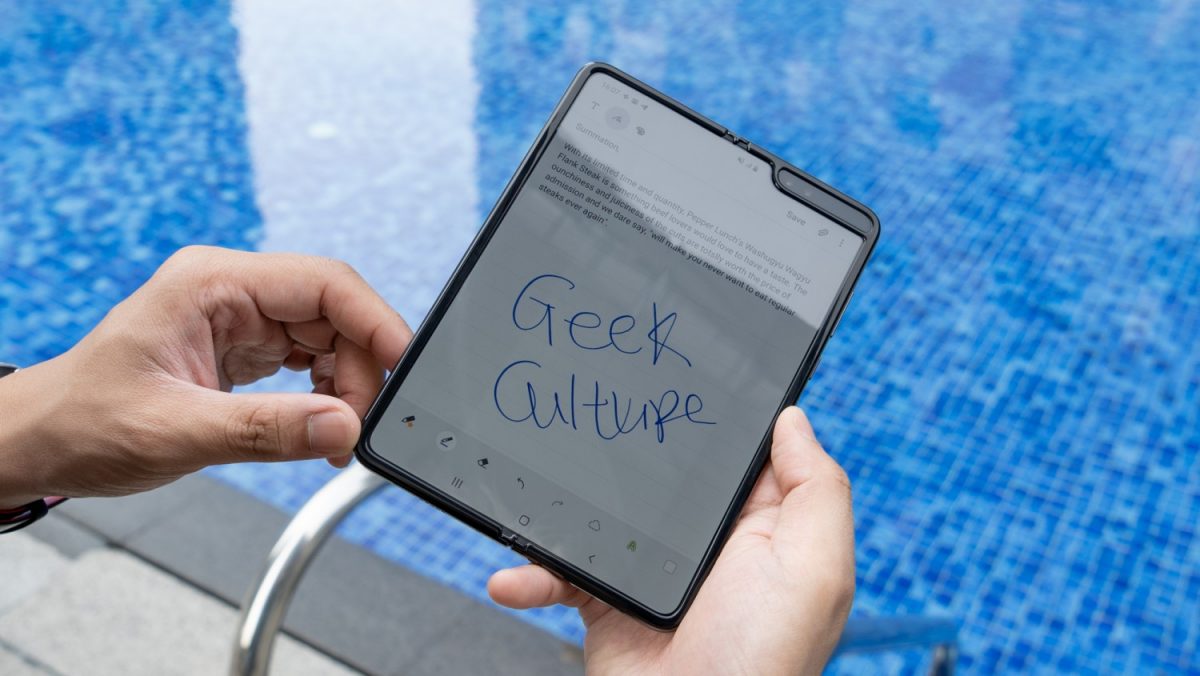
Still, if you’ve the cash to splash, nothing should stop you from getting the Samsung Galaxy Fold.
GEEK REVIEW SCORE
Summary
Samsung tried its absolute best to create a smartphone/tablet hybrid that aims to straddle between the strengths of the two, and in most aspects, did admirably. However, if you’re looking for a top-performing device, though, this one’s not it, as it ultimately becomes a jack of all trades, master of none.
Overall
8.1/10-
Aesthetics - 8.5/10
8.5/10
-
Build Quality - 8.5/10
8.5/10
-
Performance - 8.5/10
8.5/10
-
Value - 7/10
7/10
-
Geek Satisfaction - 8/10
8/10
User Review
( votes)Marion has a serious RPG addiction. Sometimes it bleeds into real life; he forgets to sleep because he thinks he has a Witcher’s body clock. Forgive him in advance if he suddenly blurts out terms such as “Mind Flayer” and “Magic Missile”, because never once does he stop thinking about his next Dungeons & Dragons game.

